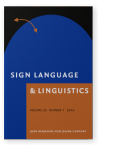Vol. 22:1 (2019) ► pp.1–43
The noun-verb distinction in Catalan Sign Language
An exo-skeletal approach
This paper investigates the morpho-phonological differences between the members of related noun-verb pairs in Catalan Sign Language. Like parallel investigations in other sign languages, our experimental work provides evidence that the major differentiating factors between related nouns and verbs materialize in the movement component of signs and non-manual markers, thus providing empirical support to the hypothesis that most noun-verb pairs have different morpho-phonological properties. We distinguish different types of movements, which we categorize into four regular morphological subgroups. We also take into account a fifth group that shows no apparent movement distinction. Concerning non-manual markers, we provide empirical evidence that nouns are mostly produced simultaneously with mouthing, in contrast to verbs, which in a smaller proportion are produced mainly with mouth gestures. Crucially, the fifth group presents the largest ratio of mouthing for nouns and even for verbs. We address these findings within an exo-skeletal theoretical syntactic approach (Borer 2005a,b, 2013, 2014).
Article outline
- 1.Introduction
- 2.Studies on noun-verb pairs in sign languages
- 3.Methodology
- 3.1Participants
- 3.2Materials
- 3.3Procedure
- 4.Results
- 4.1Differences related to movement
- 4.1.1Group 1: Roots without path movement
- 4.1.2Group 2: Roots with a simple movement
- 4.1.3Group 3: Roots with repeated hand-internal movement
- 4.1.4Group 4: Roots with path movement
- 4.1.5Group 5: Pairs with no apparent distinction
- 4.2Differences related to the duration of the articulation
- 4.3Differences related to the non-manual markers (NMMs)
- 4.4Differences related to the encyclopedic content of the root
- 4.5Interim conclusions
- 4.1Differences related to movement
- 5.An exo-skeletal account of the N-V distinction in LSC
- 5.1Theoretical background: The syntactic approach of Borer
- 5.2The role of movement from an exo-skeletal perspective
- 5.3The role of non-manual markers
- 5.3.1Mouthings
- 5.3.2Mouth gestures
- 6.Conclusions
- Acknowledgements
- Notes
-
References
For any use beyond this license, please contact the publisher at [email protected].
